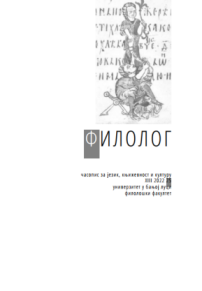MORFOLOŠKA PRODUKTIVNOST SLOŽENIH IMENICA U ENGLESKOM JEZIKU NA NIVOU PRAVILA TVORBE
MORPHOLOGICAL PRODUCTIVITY OF COMPOUND NOUNS IN ENGLISH AT THE LEVEL OF WORD-FORMATION RULES
Author(s): Maja M. Žarković Mccray, Maja R. KujundžićSubject(s): Language and Literature Studies, Morphology
Published by: Филолошки факултет Универзитета у Бањој Луци
Keywords: morphological productivity; the level of word-formation rules; word-formation types; morphological types; compound nouns; English;
Summary/Abstract: This paper tries to present morphological productivity of compound nouns in a corpus comprised of news, literary, academic and TV registers using an onomasiological approach, namely, the productivity at the level of word-formation rules. The productivity at the aforementioned level is the union of the productivity at the level of word-formation types and morphological types. By using manual, descriptive, analytic and statistical methods, we came to 571 examples of compound nouns that fell into 10 different conceptual categories (Agent, Action, Result, Object, Location, Instrument, Substance, Time, Quantity, State), i.e. clusters. Each cluster offered pieces of information on the interaction of different concepts within different word-formation types together with the morphological aspect through different morphological types, which was the aim of the paper. The results proved our initial hypothesis that the interaction of different elements is of the utmost significance for better understanding of compounding. The interaction of two concepts dominated all clusters while the combination of two stems, especially two nouns, dominated morphological types.
Journal: Филолог – часопис за језик, књижевност и културу
- Issue Year: 13/2022
- Issue No: 25
- Page Range: 49-67
- Page Count: 19
- Language: Serbian

